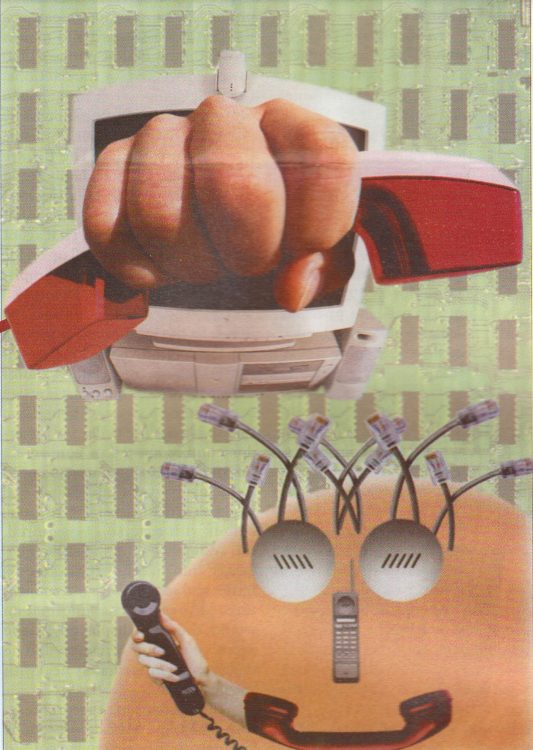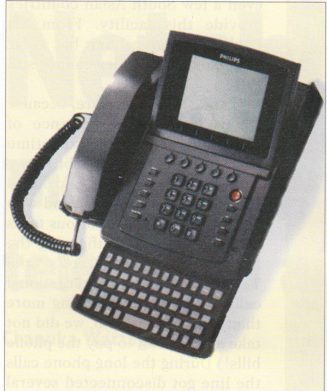Chanuka Wattegama
BECAUSE WE HAVE BEEN using it for a long time and because it had always been quicker than sending a letter through the ordinary post we hardly realize how inconvenient and inefficient it is to use a telephone for communication purposes. Just think about its dark side. I want to call someone. Before dialing his number I should have an idea where he is at that exact moment. There is no point in calling his residence, if he is at office and vice versa. Perhaps his line may be engaged. Perhaps he may be in a meeting and could not be disturbed. Perhaps he may be busy with a client, so he may ask me to call back. Perhaps his boss had lectured him just few minutes before the phone call and he may try to ease his tension over me.
Now see what e-mail can offer. Before sending a message I do not have to know where the receiver is at that moment, and since I am not disturbing him I can send the message even at midnight. If he knows how to do it, the person to whom the message is intended to can collect it from any computer connected to Internet from anywhere in the world. (Here’s a good example. I have sent an e-mail to one of my friends in India, without knowing that he has left for USA for a
software conference. No big deal. He received the message and responded the next day.) Usually a person collects his e-mail messages when he is free, and this gives him more time to give a more productive reply. He does not have to yell ‘Hold the line, the information you require is in a file and I am searching for it!” or “The list is too long. Shall I fax it?”
When you want to make an international phone call, several more inconveniences are added to the list. You have to think about the time zones, and you may have to preplan the call. Not to mention the cost. International phone call charges are and had always been sky high and in spite of all the technological innovations they do not show any sign of coming down. Unlike e-mail for which you pay only the local phone charges and a reasonable fee for the Internet Service Provider, international phone calls cost you a fortune.
With all these disadvantages, most of us still prefer making a phone call than using e-mail. May be because old habits die hard. May be because as human beings, we find the voice of our friends and relatives more soothing than lifeless text that appear in our computer screens. A psychologist will tell you exactly why, but you do not have to be the one to predict that the telephones are not going to die. At the most, the Internet and e-mail facilities will eventually make the facsimile machines obsolete, just like computers sent manual type writers to junk yards, but the telephone is going to stay with us for- ever. At least it appears so now.
Nevertheless, the face of it will change beyond recognition. The cellular mobile phone was just the beginning. Now comes another innovation: ‘Net-phones”.
Throwing away the technical jargon, a Net-phone is a cross between a telephone system and a computer system. Somehow, depending on the contribution of each component, the outcome varies. It can be a simple phone, just like the one resting on your table, and act like one with little differences. Or, it can be a computer assisted PBX (Private Board Exchange), which from your end appears nothing different to the one you may have at your office now, but physically just a small card installed in a personal computer, sans multi colored wires. Such a PBX has some additional features like handling phone calls automatically, so even without an operator it can route phone calls to the appropriate departments. It can also be a ‘Call-back’ system, which gradually gains popularity among

those who want to make international phone calls at cheaper rates.
Take the basic Net-phone first. Physically, it is nothing but a speaker (a head phone or an ear phone will also do) and a mike connected to a computer. This strikingly simple attachment, with the help of Internet and some software utilities will enable you to dial an international number for the local phone charges plus a nominal fee like Rs10 per minute to USA. (This fee varies according to the country and does not depend on the distance. For example, it will cost you more to take a phone call to a friend in Dehiwala, than to one in Minneapolis.) How can it perform such magic? It only uses Internet facilities for the transfer of digitized voice signals, instead of data as usual. Just as in the case of e-mail, you dial a local Internet web server, paying local charges, and Internet will handle the rest of the communication process. The bad news is you can communicate only with a person who has a dedicated communication server in the country he resides, and not all countries come under that category. Almost all the developing countries and some middle-eastern countries and even a few South Asian countries provide this facility. From Sri Lanka, you can call out but as far as I know an outsider cannot still call in.
I can tell you for sure, because I have firsthand experience of checking this facility sometime back. In fact, I am in debt to my colleague Dennis, who found out all the information about it and who had performed the laborious tasks of installing and configuring the Net-phone. Using Netscape’s ‘Cool Talk’, we took a few international calls, some of them lasting more than half an hour. (No, we did not take a bank loan to pay the phone bills!) During the long phone calls the line got disconnected several times, but perhaps it can be due to our low quality telephone lines which do not support high speed communications. I am sure a 64kbps WILL (Wireless In Local Loop) line would have given better results.
CoolTalk is not the only software utility that supports a Net- phone. US edition of the October 1996 PC Magazine reviews nine such software products including Intel’s ‘Internet Phone’, Microsoft’s ‘NetMeetng’, PowWow from Tribal Voice and Quarterdeck’s “WebTalk’. The editor’s choice is “WebPhone’ from NetSpeak Corporation. Information about most of these software packages are available on the web and any interested party can find them easily after a brief search. I can recommend the search engine ‘Lycos’ for this purpose which I have used and was really productive. If you do not have access to the net, ‘Internet Telephony for Dummies’ is an excellent book on the subject.
So why isn’t everyone using Net- phones? One reason is that audio quality remains a problem. A Net- phone call never sounds as good as an ordinary phone call. Not only does your digitized voice sound irritating to a human ear, but there can be gaps of several seconds as it makes its way across the Internet.

We experimented with several types of sound cards available in the Sri Lankan market. Some vendors even brought full duplex cards from Singapore specially for us, but none of the cards could provide an acceptable solution to this problem.
The other problem is the interoperability standards. If you want to call someone today, you should have the same software at both ends. Standards for all someday make it possible for you to own the software you prefer and still communicate. But that day is a long way off.
Then, enter ‘Call-back’ systems. Readers of the international magazines like “Time’ and ‘Newsweek’ might be familiar with sporadic advertisements promoting such services. A word of caution here: Some of the call-back services use communication channels in an unbefitting manner. It is a long story how they do so. Let us just say that they operate without the proper approval of the telecommunication authorities of the respective countries, so depending upon the telecom rules and regulations of that country, sometimes that becomes illegal. Anyway, the advertised services have to be proper, and there is nothing wrong in using them.
To use one, you have to open an account with one of these telecom operators, and get an international number to dial in. You do not have to pay international telephone charges. You are charged a certain fee, and on most of the occasions it is roughly half what you pay if you were to take the phone call by ordinary means and in some cases as low as 10% of it. Do not ask me who provides such a service in Sri Lanka, because according to my knowledge, there isn’t any local operator yet. On the other hand, such services are nothing new to Asia. Countries like India, Malaysia etc have telecom operators who provide such services.
This is how this scheme works: Using the IDD line you call a computer operated switching system, usually setup in USA, where rates for international calls are relatively low. After one or two rings the switching system disconnects the phone call, but before doing so it automatically records the number where the call originated. The call is not complete, so you pay nothing. In half a minute or so, the switching system calls back automatically. When you pick it up, you hear a dial tone and can dial the number you need. Somehow, reveals the ‘Time’ magazine of 16th June 1997, which does a small but very informative piece on the subject, this is not a new technology. It just takes advantage of the price gap in different countries for the same service.
According to the International computer magazine ‘Byte’, several massive business organizations use computer controlled phone systems for their customer support services. Citibank has joined forces with Philips Home Services to deliver financial services via a screen phone. Home customers can use the pull-out keyboard and menus shown on the Philips phone’s LCD to perform bank transactions. Compaq Computer customers can get faster, better online support by typing in their customer IDs using their phone’s keypad. The IDs are routed to a customer database on the network, which tells the PBX which customer support agent it should route the call to. That agent can then immediately call up on his computer screen all the appropriate background on the customer.
Gateway 2000, another big player in the PC market, is looking into the possibility of using Computer/ Telephone integration to automate order status queries. Gateway is examining a voice response system that asks the caller for his order number and other confirming information. No human would need to be involved at the vendor’s end to check order status. Where interaction with a person is required, the system would first get the necessary information from the customer and route it with the connection to the agent. That information. would then be displayed in the agent’s computer screen so that he or she could immediately deal with the customer.
What constrains the proliferation of Net-phones at present is surprisingly not technological but financial and business reasons. From the point of view of the customers it is most certainly a positive change, but what about the telecom operators who are about to loose the massive amounts they earn through long distance phone calls, if such systems are introduced? They may try their best to suppress this innovative technology, but I am sure that will hardly be successful. One day, not long away, they would have to step back willingly or unwillingly to pave the way for that marriage between the telephone and the computer.



